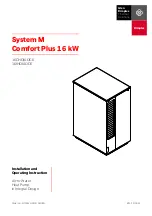
BA-
45.01.0 • US •01/15
4-3
4. Installation
4.2.4
Safety vessel (4.1/16)
The safety vessel (at the lowest point of the suction
pipe) must be so constructed that
incoming air does not directly flow onto the liquid
surface,
there is a sufficiently large settling space,
the filter element never dips into the liquid (even
filters of non-absorbent material fill up with liquid
due to capillary action).
When a vacuum filter of the type SFA-F is used, a filter
element is not necessary in the safety vessel.
The following diagram shows an optimized gravity
separator. The function must be checked as follows.
When the water volume to be separated is sucked in,
the volume must remain in the vessel,
in atmospheric suction, not more than 1 litre per
hour must be drawn in.
We will be pleased to support you in the
calculation and testing of your safety vessel.
Noise suppression (low noise
installation)
The
noise
level
of
the
rotary
compressors/
compressors and vacuum pumps of the RFW series is
far below the value permitted for commercial vehicles.
To preserve these values when the machine is
installed, the low noise installation is necessary.
4.3.1
Air noise suppression by noise
suppressing oil separator (4.1/9)
The combined silencer and oil separator suppresses
the exhaust noise of the compressor and vacuum
pump, and it also removes 80% to 90% of the
lubricating oil.
The silencer is installed between the machine and the
four-way tap, or in the exhaust pipe.
The noise suppressing oil separator must be
permissible for the maximum possible operating
pressure (e.g. 2 bar excess pressure if the machine is
used as a compressor).
The de-oiling element is connected by 2 or 3 oil
draining pipes to a ventilated collecting tank with a
capacity of at least 10 litres. The ventilation diameter
should be at least 1".
In the draining pipes between the oil separator and the
collecting tank, covers of 4 mm diameter are fitted.
The collecting tank must have a draining point for
condensate.
When mounting the silencer, the flow
direction must be taken into account; the oil
draining
outlet
must
point
vertically
downwards.
1.
Curved inlet pipe
2.
Flow absorption plate
3.
Double perforated sheet
4.
Draining tap
5.
Two ball floats
6.
Four guide rods
Figure 4-2:
Safety vessel















































